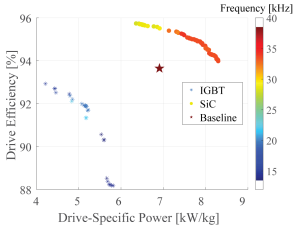Electromagnetic Modeling and Optimization of Inverter-Driven, High-Frequency, Slotless Permanent Magnet Synchronous Machines
Xiaolong Zhang with adviser Kiruba Haran
High-frequency, slotless permanent magnet synchronous machines (PMSMs) can minimize the iron usage and increase the specific power. This class of machines can operate at variable speeds with an inverter drive; thus, it is promising for weight-sensitive applications such as aircraft electric propulsion systems. Figure 1 shows a 300 kW, high-frequency, slotless PMSM system under test with two reactors connected. The goal of this project is to develop a computationally efficient design program for the machine and drive to optimize system weight and efficiency. High-magnitude harmonics are usually introduced to the machine excitation currents due to pulse modulation processes. These harmonics will induce additional losses in the copper windings, iron yoke, and rare-earth permanent magnets. Machine performances under such harmonic-rich excitations are modeled using electromagnetic field partial differential equations. The accuracy of this modeling approach has been validated by experimental tests. A genetical algorithm program integrating the accurate analytical model is developed to find the optimal tradeoff among various design parameters such as motor diameter, pole count, current density, filter size, inverter switching frequency. Figure 2 plots the optimization pareto fronts using two different inverter switches, i.e., conventional silicon insulated-gate bipolar transistor (IGBT) device, and wide-band-gap silicon-carbide (SiC) MOSFET device. It is demonstrated that designs with the wide-band-gap device can significantly increase the switching frequency to 30-40 kHz and yield substantially higher efficiency and specific power. This research is funded by Grainger CEME and Center for Power Optimization of Electro-Thermal Systems.

